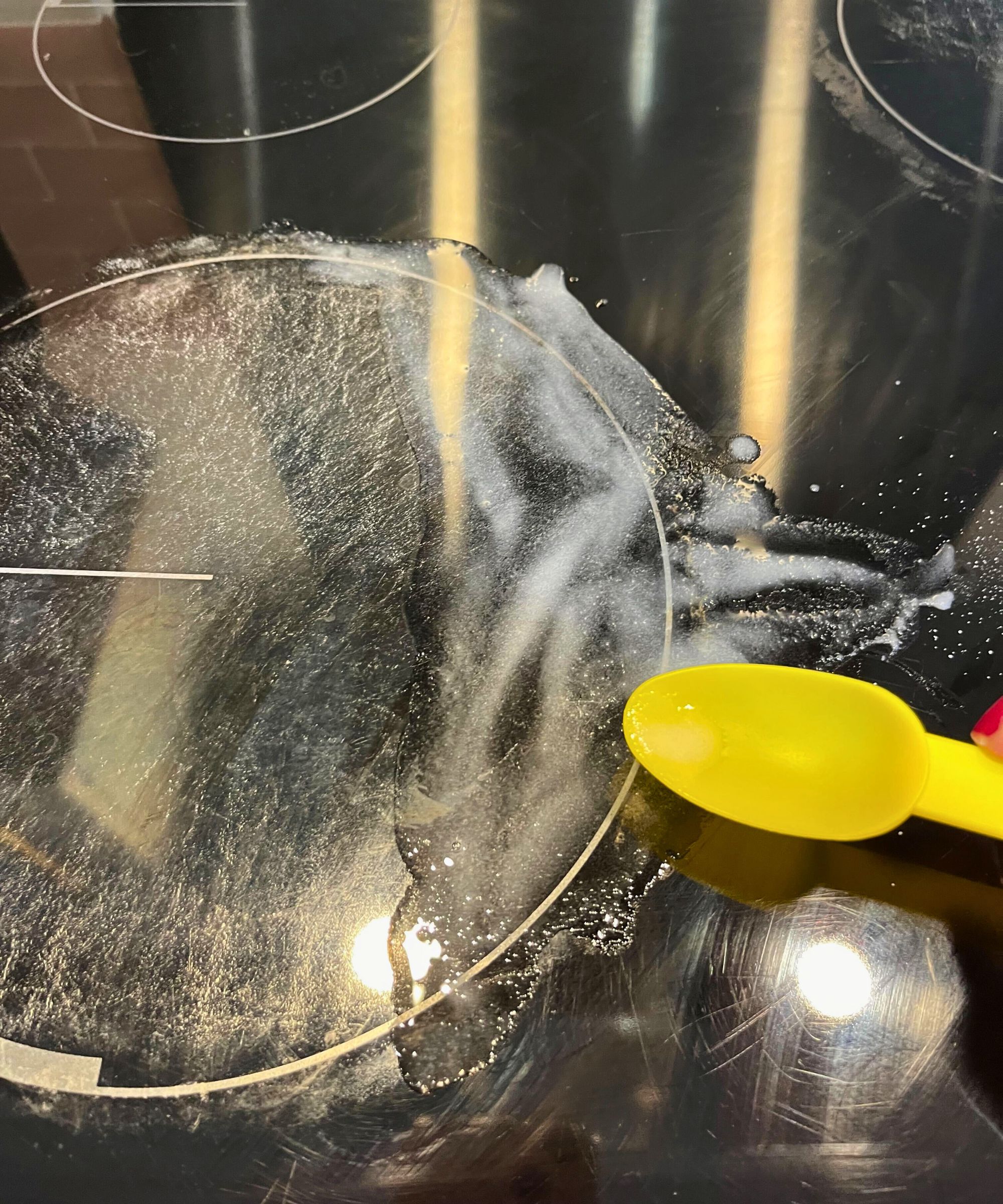I couldn’t get stubborn scorch marks off my glass stovetop for 4 years until I tried baking soda – it worked like magic
I can't believe I didn't do this earlier


My home was newly built when we moved in, and it was spotless. The glass hob, the first electric one I'd ever had, was new to me and within a few weeks, I had scorched the glass with the bottom of a pot.
I tried for four years to scrub the marks away and eventually accepted those marks were not budging. Then, I interviewed dozens of cleaning experts for my role as head of Solved here at Homes & Gardens and realized baking soda was a brilliant, gentle, natural and crucially, abrasive cleaning agent.
I gave this cleaning tip a go and was amazed to see the scorch marks around the edge finally lift. Here's what I did, and how you can utilize baking soda on your glass stovetop without worry.
Using baking soda on glass stovetop scorch marks
It's quick, easy and very effective. Here's what I used if you decide to give it a go.
- Baking soda, available at Walmart, or your your usual grocery store.
- A microfiber cloth, also available at Walmart
- A Scotch-Bright sponge, available in a multi-pack at Walmart
The scorch mark problem I had on my glass stovetop

I cooked Persian sweet and sour cherry rice with saffron chicken, a dish called Albaloo-polo ba morghe (cherry rice with chicken), on my electric stovetop
My heritage is Persian and boy, do we like to cook. Rice is on the menu most days in our home and even the most experienced rice-cooks like me make a blooper every now and then, seeing water spill over the edge of the pot and onto the glass stovetop.





The only problem for me was spills like those left a scorch mark on the stovetop, usually in a ring. The ones on the right side, seen below, were really stubborn and wouldn't lift. I tried cleaning my glass stovetop with commercial cleaners and even a homemade glass cleaning spray with nature's powerful cleaning agent, vinegar. It didn't work on the scorch marks you can see on the right:

The scorch marks on the edge of the rings of my electric glass stovetop were so hard to shift
Add to that my husband's pasta-only cooking repertoire, and the front left ring got an absolute battering weekly. After a while, I accepted I was never going to get rid of those burn marks around the edge of the ring, despite cleaning the stovetop after every cooking session.
Then Karina Toner, operations manager and cleaning pro at Spekless told me about using water and baking soda, available at Amazon, to make a quick and easy cleaning paste.

I buy my baking soda in bulk because I use it for so many cleaning and deodorizing jobs around the house, including when there was a stinky spill on the sofa, and to freshen up carpets, mattresses, and scrub with during cleaning tasks.

I use a 3 quart pot similar to this one which is non stick and has a lid for my Persian cooking. The wide flat bottom is perfect for cooking crispy tahdig at the bottom of my rice, which cooks evenly and without burning the center. A 3 quart will easily fit 6-8 portions of rice.

I swear by microfiber cloths for cleaning and dusting. They wash well and last for a long time. Just avoid using fabric softener on these as that will compromise its ability to soak up as much liquid. Make sure to wash dirty cloths on a hot wash to kill bacteria.
What I did
This cleaning job was really easy to carry out and I did it while the kettle boiled for a cup of cardamon tea. So, you'll need only five minutes and a few items to try this yourself.
- Make a paste. I used a tablespoon of baking soda, and added a little water till it was a gritty paste.
- I then spread it around the glass stovetop but only on the scorch marks on the right side to test easily. Use it wherever you need.
- I left it for the few minutes it took for my kettle to boil, then used a sponge to gently rub the paste in circles on the scorch marks. Voila! It came off.
- I then used a damp microfiber cloth to lift away the paste and dried the area with a paper towel.



Perfect! After all that time thinking the scorch marks were permanent and a part of having a glass stovetop, I realized it didn't have to stay looking that way.
When you try it on yours, give it a go on the back half first, just to make sure there aren't any adverse effects to the surface. It shouldn't be an issue, but as with all new cleaning methods, it's best to try it on a discreet area first.
My verdict
It worked really well on the perimeter, where I focused my efforts (as I was running out of baking soda) and I honestly couldn't believe I had lived with the scorch marks for four years. A real boon.
It is worth noting it didn't get all the marks off in one go but I am OK with that. I will implement this into my regular kitchen cleaning checklist and feel confident over time, it'll be easier to maintain a clean and scorch-free stovetop.
When I next have my stock of baking soda in, I will try it on the whole ring and report back here.

Before

After
Next, delve into the lemon hack I tried when cleaning stubborn water marks from my faucets and how it banished limescale I hadn't been able to shift with commercial cleaners.
Plus, learn about all the things you can clean with baking soda around the home.
Sign up to the Homes & Gardens newsletter
Design expertise in your inbox – from inspiring decorating ideas and beautiful celebrity homes to practical gardening advice and shopping round-ups.

Punteha was editor of Real Homes before joining Homes and Gardens as Head of Solved. Previously, she wrote and edited lifestyle and consumer pieces for the national press for 16 years, working across print and digital newspapers and magazines. She’s a Sunday Times bestselling ghostwriter, BBC Good Food columnist and founding editor of independent magazine, lacunavoices.com. Punteha loves keeping her home clean, has tested and reviewed the latest robot vacuums, enjoys cooking, DIY, and spending weekends personalizing her newly-built home, tackling everything from plumbing to tiling and weatherproofing.
-
 7 tiny chores that instantly make your home look more put together without buying anything – including shopping your stash and quick decluttering
7 tiny chores that instantly make your home look more put together without buying anything – including shopping your stash and quick declutteringSimple organization can make a real impact, experts assure
By Ottilie Blackhall
-
 Want to make your home look more charming? These 4 Benjamin Moore exterior shades will up your curb appeal
Want to make your home look more charming? These 4 Benjamin Moore exterior shades will up your curb appealIf you're on the prowl for a new shade to try for the outside of your home, Benjamin Moore has unveiled its most 'charming' colors
By Sophia Pouget de St Victor
-
 5 freezer cleaning mistakes you must avoid – or risk compromising your food quality and shortening the lifespan of your appliance
5 freezer cleaning mistakes you must avoid – or risk compromising your food quality and shortening the lifespan of your applianceAvoid these blunders for a safer kitchen
By Seraphina Di Mizzurati
-
 If your home's facade is riddled with cobwebs, this $12 tool makes cleaning once-unreachable spots simple and speedy
If your home's facade is riddled with cobwebs, this $12 tool makes cleaning once-unreachable spots simple and speedySay goodbye to cobwebs and hello to a fresh and clean facade
By Rebecca Shepherd
-
 I tried the Pomodoro Technique to blast through my spring cleaning to-do list – now I'll always rely on it to banish procrastination
I tried the Pomodoro Technique to blast through my spring cleaning to-do list – now I'll always rely on it to banish procrastination25 minutes is more than enough to make a real difference
By Ottilie Blackhall
-
 5 things people with clean mudrooms always do – it will consistently and easily keep dirt at bay
5 things people with clean mudrooms always do – it will consistently and easily keep dirt at baySay goodbye to muddy spring foot prints with these expert-approved tips
By Eve Smallman
-
 Bissell CleanView XR Pet 300W Stick cordless vacuum review – it's a great budget vacuum, but by no means perfect
Bissell CleanView XR Pet 300W Stick cordless vacuum review – it's a great budget vacuum, but by no means perfectLow price point, but with the cleaning performance to match it
By Camryn Rabideau
-
 'It's surprisingly effective' – How to clean with white bread, and why this pantry staple might be just what your cleaning routine is missing
'It's surprisingly effective' – How to clean with white bread, and why this pantry staple might be just what your cleaning routine is missingIs this unusual cleaning hack the best thing since sliced bread?
By Ottilie Blackhall
-
 I’m a professional cleaner, and I swear by these quick and easy tips to clean pet hair from wooden floors
I’m a professional cleaner, and I swear by these quick and easy tips to clean pet hair from wooden floorsStaying on top of the mess makes it 10 times easier
By Carolina Kazimierski
-
 I tried this glycerin hack to stop the mirror in my bathroom from fogging up – and it worked like magic
I tried this glycerin hack to stop the mirror in my bathroom from fogging up – and it worked like magicIt instantly fixed one of my biggest pet peeves
By Chiana Dickson